|
FEATURE STORY -- SHIMANE MUSEUMS
-- Tanabe Museum of Art --
Modern Tea Forms Exhibition
20th Anniversary Special Exhibition
From May 24 to June 22, 2003
310-5 Kitahori-cho, Matsue City
Shimane Prefecture, 690-0888
TEL: 0852-26-2111
Also Shown at Mitsukoshi Dept. Store
Nihonbashi, Tokyo, from May 13 to 18, 2003
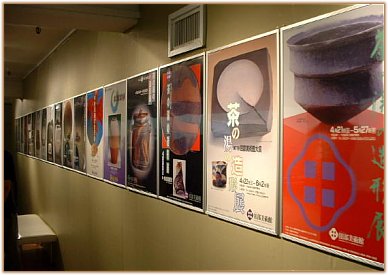
Posters of Past Tea Forms Exhibitions
There are many ceramic museums throughout Japan. One of the leaders in the Tea World is the Tanabe Museum of Art located in Matsue, Shimane Prefecture. It was established in 1979 by Tanabe Choemon XXIII, the late Shimane Prefectural Governor, and it displays the family treasures, mostly chadogu or tea utensils, of 25 generations of the Izumo region's Tanabe clan. One of the museum's more forward-looking projects was the creation of the Modern Tea Forms Exhibition (Chanoyu Zokei Ten). The exhibition, held annually, was established in 1984 to celebrate the fifth anniversary of the museum. The exhibition is juried by many of Japan's top tea critics, the chief honcho being the extraordinary Hayashiya Seizo. Hundreds of works are submitted each year for the six-member jury.
23 Photos Below - Click thumbnails to see larger photos
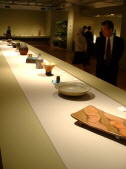 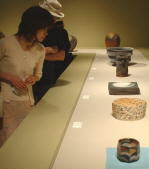
The exhibition has two key words: mitate (selection-choice) and challenge. All of the submitted works are from the western part of Japan, with most entries coming from Okayama Prefecture, home of Bizen-yaki. Until now, the yearly exhibition was shown exclusively in western Japan, and never before to audiences in eastern Japan. But this year, a five-day 20th anniversary exhibition was given in Tokyo at the Mitsukoshi Department Store's large hall from May 13 to 18. What a shame it was only for such a short time -- considering all the effort required to get hundreds of works to Tokyo, including the most selected and award-winning pieces from past exhibitions. The Tokyo audience understood this effort and the short time to see the exhibition. I went on the first day just after opening time and the place was already jam-packed! I heard it was like that for the entire five days.
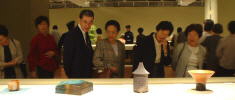
Inside the exhibition
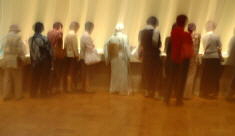
Inside the exhibition
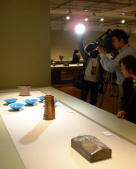
The TV news must have helped with attendance
Chadogu continues to be enormously popular among the Japanese
For the 20th exhibition, the breakdown of chadogu was:
- 28.5% chawan (tea bowls)
- 24.6% vases
- 13.2% mizusashi (fresh water vessels)
- 13.2% hachi (serving bowls)
- 9.1% tsubo (jars)
- The remainder were chaire (tea caddies), koro (incense burners), tobako (ceramic boxes) and others
This information was all laid out in the exhibition's catalog. As for the ages of the artists, the majority were born between Showa 21-25 (1946-50), the eldest in the first few years of Showa (1926-) and the youngest from the early 1970s. It's been said that the best chadogu are made when a potter is in his fifties and beyond.
It was an outstanding exhibition with a wide variety of styles including Bizen, Hagi, Hakuji (white porcelain), Raku, Tamba, and colorful Neriage. Please see our Guidebook for details on each style.
It seems like hakuji and celadon are the rage these days, for the grad prix prize went to Maeda Akihiro's graceful spiral tsubo. Compare that to the recent Japan Ceramic Art Exhibition, in which a celadon hachi was awarded the grand prix (see JCA link for photo). The coolness these works impart certainly fits the summer.
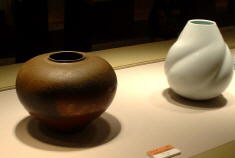
Graceful Spiral Tsubo (white piece) by Maeda Akihiro
Won this year's grand prix award
Other standouts in the exhibition were Mihara Ken's sleek sekki vessels (Mihara is a frequent award winner, won the 18th grand prix), Ajiki Hiro's lively creations, including below mizusashi that won the 4th grand prix, and Kakurezaki Ryuichi's elegant Bizen vase that won the 5th grand prix.
 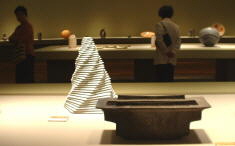
(L) Piece by Mihara Ken (R) Sekki vessels by Mihara Ken
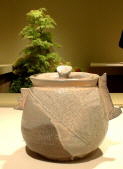 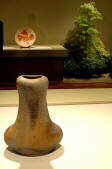
(L) Mizusashi by Ajiki Hiro, winner of 4th grand prix
(R) Vase by Kakurezaki Ryuichi, winner of 5th grand prix
Actually, Kakurezaki is the only Bizen potter to win the top prize twice - he also won the grand prix in the 9th exhibition for a modern lacquer-topped mizusashi. Other Bizen potters to have won the grand prix are Kawabata Fumio (7th), Yamamoto Yuichi (13th), Yamashita Joji (14th), Isezaki Mitsuru (15th), Wani Eiko (16th), and Yamamoto Izuru (19th). Another two-time winner of the top prize is Hagi potter Okada Yutaka (1st and 6th) for his white-glazed yohen mizusashi.
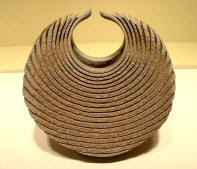
Piece by Yamamoto Izuru, winner of the 19th grand prix
It's quite a challenge to be innovative in the tea world, and as much as the judges were looking for originality and grace in works, some of the forms have been seen before, including Isezaki Mitsuru's award-winning notched Bizen mizusashi and Morimoto Tokoku's Tamba chaire, both looking very 16th century.
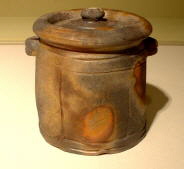 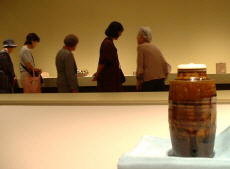
(L) Bizen piece by Isezaki Mitsuru
(R) Tamba piece by Morimoto Tokoku
This is not necessarily a negative thing, for not much can be done to "improve" a mizusashi or chaire per se, but there were a smattering of works that lacked vitality. As I've said before, new forms just for the sake of newness often don't perform their functions properly. A 12th century sake cup that I have still has the power to connect to the heart. I wonder what the viewer will think of these works a few centuries down the road.
In the Tamba realm, fresh works included the decorative yet subtle chawan and kogo by potter Ichino Masahiko. I was also taken with Nishihata Tadashi's (also a Tamba potter) energetic ash-glazed dishes.
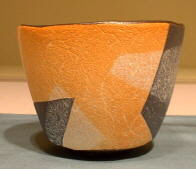 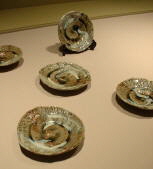
(L) Piece by Ichino Masahiko (R) Dishes by Nishihata Tadashi
Other highlights included an etched yakishime mizusashi by Yamato Kiyoshi, Ono Shinya's neriage box, and Tsukioka Mitsuru neriage mizusashi. The latter piece won the grand prix in the 10th exhibition.
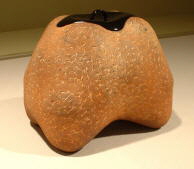 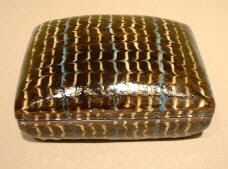
(L) Yakishime Mizusashi by Yamato Kiyoshi
(R) Neriage box by Ono Shinya
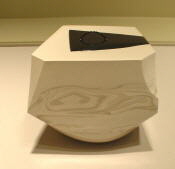
Neriage Mizusashi by Tsukioka Mitsuru
Won the grand prix in the 10th exhibition
All these vessels are fine craftworks that become art when matched and arranged with hanging scrolls, flowers, other chadogu, and people in the cosmos of a tearoom. The Tanabe Museum deserves much praise for sponsoring such an ambitious event.
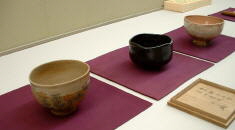
Also displayed were some of the museum's older treasures
Pictured here are three chawan, helping link the old to the now
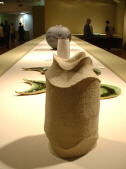
Front piece by Mori Togaku
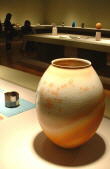
Hagi Tsubo by Nakamura Takeo
Prize-winning Hagi piece
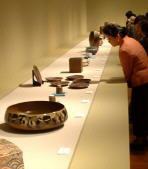
Various pieces on display
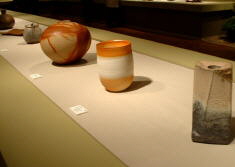
Various pieces on display
LEARN MORE
More can be learned about many of the potters mentioned above by visiting the e-yakimono.net Who's Who page.
|